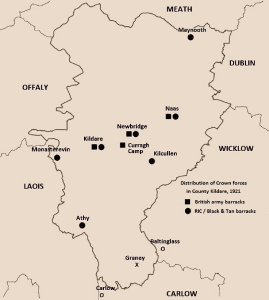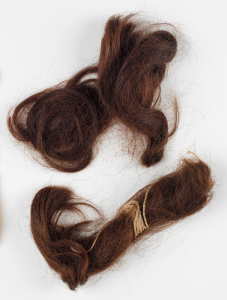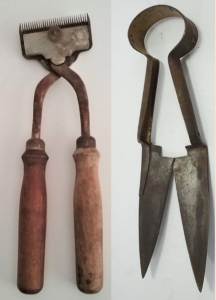Boycott of Crown Forces and
Gender-Based Violence in Kildare,
1920–21
Published in the Kildare Nationalist, 9th of February 2021
One hundred years ago during the most intense period of the War of Independence, terror, assassination, and reprisal were the order of the day. Resistance to British rule took many forms, which included militancy and a general boycott of both the RIC and British army. The boycott of the army in an area known as the Curragh triangle which included Newbridge and Kildare town was very difficult to implement. Census figures indicate that the British army population in the Curragh and adjoining towns outnumbered the local civilian population. The area was more heavily dependent on the British Army for employment, and commercial trading than any other region in the country. The vast majority of local people were employed in the various army barracks in the region and in spin-off industries. Newbridge regarded as the retail hub for the military and its personnel.

Map showing distribution of Crown forces in County Kildare, 1921 and locations associated with gender-based violence.
Social interaction between the army and local people was a way of life in the Curragh region with sporting and social events organised by the military attracting large numbers from the locality, particularly from Newbridge. The annual sports events in the Curragh Camp were a major attraction for the local people of all classes with entertainment impressively provided by various regimental bands.
The 12th Lancers in particular were regarded as one of the most popular regiments in the locality at the time and were at the forefront in organising many events. In 1919 they organised a well-attended dance in the Sports Club at the Curragh which raised a substantial sum in aid of Mercer’s Hospital. The dance was virtually an all-night affair with dancing continuing until 5am. The following year the Lancers and the Carabiniers combined to organise a successful Point to Point races at Boston in the Red Hills near Kildare. British army regimental records from May 1921 indicate that 466 men of all ranks belonging to the Lancers were quartered in Ponsonby [now Plunkett] Barracks in the Curragh Camp. Extensive social interaction between the military and the civilian population produced numerous marriages particularly in Newbridge. A survey of marriages in a number of Church of Ireland and Catholic churches from the 19th century in the Curragh region show that of 7,103 marriages 966 were military weddings in which 624 brides had local addresses. While the boycott and militancy directed against the British army was very intense in many parts of Ireland there seems to have been an unwritten understanding between the army and the militants in the Curragh region during much of the War of Independence with soldiers openly going about their daily life in Newbridge and Kildare town similarly to military personnel in Britain and most of Ulster. In the more militant areas of the country soldiers were targeted by the IRA in the same way as the Black and Tans.
Women fraternising with soldiers received heavy handed treatment from the IRA. A suspected girl would receive a warning first, then if the association continued the unfortunate girl would be subjected to violence which included forcible hair cutting. Two serious and disturbing incidences were reported in County Kildare in the Summer of 1920. A young girl cycling from Glencannon near Baltinglass to Rickardstown close to Newbridge who was suspected of being friendly with a soldier was overpowered by five masked men, taken into a field by two of them and had all her hair cut off. In South Kildare two girls from Carlow town while cycling to Baltinglass were held up at Graney by eight masked men and subjected to forcible haircutting with a horse clippers. They had previously been warned and had fiercely resisted the assault with one of the girls pleading with her attackers to take her life first.
Forcible haircutting was a serious assault which caused injury, subsequent trauma and even mental illness. The terror and force involved in which a victim would be frequently dragged, held down, beaten and badly shaken by the ordeal. A depiction of this terrible crime was visibly displayed in a most disturbing and upsetting way in David Leach’s Oscar winning film, Ryan’s Daughter (1970), which was shot on location in Kerry.
The Black and Tans reciprocated with reprisals targeting Cumman and mBan and female relatives of suspected IRA members. One of the more vicious assaults occurred in Limerick when a member of Cumman na mBan was subjected to inhuman treatment. During a Black and Tan raid on her house in November 1920, the girl was knocked down and dragged by her hair along a garden path where her assailants forcibly cut off her hair and also slashed her hand with a razor. A depiction of Black and Tans engaging in this form of crime is depicted in Ken Loach’s film, The Wind Shakes the Barley (2006).
As the militancy escalated in County Kildare in late 1920 the Curragh region continued to be spared the effects of the revolution that was common to most areas in the country. However, in Kildare a high number of arrests caused concern among the IRA who suspected a spy operating from within their own ranks. Suspicion fell on Bridie O’Mullane a Cumann na mBan activist, who was sent to the county by the executive of the movement in late 1920 to organise and establish new branches. Her organisational work came to an abrupt end, due to an unfortunate coincidence of her presence close to the scene of raids and arrests of prominent Kildare IRA activists in the aftermath of Bloody Sunday. Suspected as a spy, local activists decided to take appropriate action. However, she was tipped off probably intentionally by senior IRA Intelligence Officer, Sean Kavanagh, who informed her that the local IRA had plans to assassinate her and attach a label marked ‘spy’ on her body. Despite being totally innocent Bridie was obliged to leave Kildare for her own safety. It is unlikely the Kildare IRA had any intention of shooting a woman. The purpose of the tip-off was to sufficiently frighten an alleged woman spy into leaving the area. The IRA later discovered that a woman spy was active, and she took refuge in the Curragh Camp.
In early 1921, the militancy and violence were slowly moving to more peaceful districts of Kildare and by early February no area including the towns in the Curragh triangle were safe from the escalating IRA militancy. Despite this the local military authorities were slow to recognise the danger and to a large extent life and social interaction continued as normal. At 9pm on the eve of Valentine’s Day, the 13th of February 1921 while private S. Hayes from the 12th Lancers and his 24-year-old girlfriend from Moorfield, Newbridge were in a comprising position in a lover’s lane just outside Newbridge, three masked men approached. They requested the soldier to leave the scene and for the girl to remain. Private Hayes refused and the three masked men produced revolvers. The girl at this point fainted and the private who suspected that the motive was to cut the girls hair for keeping company with a soldier, refused to comply. The armed men, however, did not harm the couple instead warned them not to return to that area again and departed without harming either the soldier or the girl.
While members of the British army in Ireland particularly in periods of revolution or rebellion were not noted generally as acting in a lifesaving capacity towards the local population, Private Hayes acted with honour towards his girl-friend and while not an officer he certainly displayed noble qualities expected from an officer and a gentleman.
This is one of many examples of the IRA in Kildare acting in a more lenient manner in contrast to Munster where a similar encounter could result in the execution of the soldier and violence inflicted on the girl. The IRA while their intentions at the very least was intended as intimidation and possibly some degree of physical violence against the girl, left the scene knowing full well that the encounter would have achieved the intended effects without having to carry out a most repulsive act.
The incident was reported to the military authorities and police. District Inspector Fallon of the RIC in his monthly report for February 1919 merely stated that there was ‘intimidation of a soldier and his sweetheart at Newbridge on 13 [February]’. There were no details of the incident publicised which would have alarmed army relatives in the area and embarrassed the military authorities. The incident likewise could have damaged the local IRA and may have seriously diminished the links they had to friendly members of the RIC who occasionally passed on vital intelligence.
The RIC at the time were aware that the national leadership of the IRA were compelling local activists to increase militancy. The County Inspector Major Scott, ‘received intelligence that IRA GHQ in Dublin were dissatisfied with Kildare and ordered the Newbridge IRA to get a move on but [they] refused to carry out the order’. The local IRA knew the consequences of a greater level of militancy in the Curragh area far better than many of the IRA leadership in Dublin and they also knew their limitations when opposed by a numerically stronger British army who had a high level of support in the area.
For almost a century the nature and extent of gender-based violence in Ireland during the Irish Revolution has been ignored, hidden and suppressed. However, in recent years discussion of the issue has revealed to some degree the extent of this type of abuse. Fortunately, in County Kildare this violence appears to have been uncommon.
Sources
- General monthly return of the regimental strength of the British army, May 1921, pp 105, 108–9 (The National Archives, London [TNA], WO 73/114,).
- Returns of outrages, daily summaries, Jan–Mar. 1921 (TNA, CO 904/144).
- RIC County Inspector report for February & March 1921 (TNA, CO 904/114).
- Brighid O’Mullane (Irish Military Archives, Dublin, BMH WS 450).
- Mary McAuliffe, ‘How both sides abused women’ in Irish Independent, 21 Nov. 2020.
- Irish Times, 5 July 1920.
- Leinster Leader, 24 July 1920.
- Nationalist and Leinster Times (Carlow Nationalist), 31 July 1920.
- Kildare Observer; 31 May 1919, 27 Mar. 1920.
- Seamus Cullen, Kildare: the Irish Revolution, 1912–23 (Dublin, 2020), pp 3, 7–8, 108–9.
- Con Costello, A most delightful station: the British army on the Curragh of Kildare, 1855–1922 (Cork, 1996), pp 195–206.
- Michael Smyth, ‘Kildare Battalions’, Capuchin Annual (Dublin, 1970), 571.


